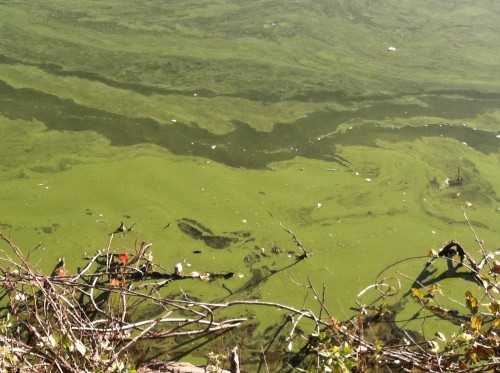The Symptom Treatment Paradigm: Unnatural (non) Solutions
“You don’t fix trouble with the same thinking that got you into trouble in the first place.”
If nutrient overloading is the problem, it doesn’t make sense to choose short-term “symptom solutions” that inevitably contribute to further nutrient overloading. To us, this way of thinking is the definition of lake management insanity.
Conventional “symptom treatment” thinking advocates the use of chemical herbicides to kill weeds, dredging to remove lake-bottom muck, and alum to control algae.
These are short-term strategies that don’t fix the deeper problem with the ecosystem. They alleviate human discomfort, but don’t restore the lake.

Symptomatic mitigation strategies and technologies:
- Don’t fix the fundamental problem of nutrient overloading and oxygen depletion
- Are not sustainable
- Don’t ensure long term lake health.
- Are potentially toxic and dangerous to human health.
Which would you rather have – a chemically treated lake or bigger, healthier fish with clear, clean water ?
FACT #1: Chemical Herbicides Kill Weeds…but Don’t Fix the Problem
- Poisoned weeds and algae blooms sink to the bottom of the lake and rot.
- The plant nutrients in them are released back into the water column and become nutrients for the next weed growth or algae bloom.
- Once the decayed biomass is formed, nutrients are effectively locked into the lake’s ecosystem to be recycled forever…
FACT #2: Weed Harvesting Clears Surface Weeds…but Doesn’t Fix the Problem
- Weed stems remain to initiate regrowth.
- The invasive species Eurasian Water Milfoil and Hydrilla spread by fragmentation. Harvesting “sows the seeds” of regrowth throughout the lake.
- Weed and algae fueling lake-bottom muck remains.
- Nutrient overloading, weed and algae growth continue…
FACT #3: Dredging Deepens…but Doesn’t Fix the Problem
- Dredging can deepen a lake but does nothing for water quality, nothing for algae, little to reduce odor and nothing to prevent fish kills or improve fish health and growth.
- Dredging ‘digs up’ PCBs that have been buried for decades in lake sediment.
- Dredging mixes phosphorus, nitrogen, and other harmful pollutants into the water column…
FACT #4: Aluminum Sulphate Doesn’t Fix the Problem
- Alum treatments do nothing to reduce nitrogen – the other nutrient critical to plant and algae growth.
- The phosphorus binds to the alum and stays in the ecosystem. ‘Locked’ phosphorus is re-released into the water column in as quickly as two years after the initial treatment.
- Alum is short lived – not sustainable – and certainly not good for the long-term health of the ecosystem…
FACT #5: Watershed Management…A Good Theory
- In a perfect world, watersheds are managed to prevent lake contamination in the first place.
- In the real world, effective watershed management is exorbitantly expensive, politically contentious, and for the most part, impractical. Human interests inevitably collide, conflict becomes entrenched, and lakes and reservoirs continue to decline…
For more in depth information, read our STRAIGHT TALK “5 Lake Restoration Myths”.
Nature has THE SOLUTION
Treating symptoms doesn’t fix the problem that’s causing them. If you stop, repair and reverse nutrient overloading…the symptoms of weeds, algae and muck will disappear. That’s Nature’s Way. That’s our way.
See Our Solution Take Action Now! Review Our Success

















Leave a Reply